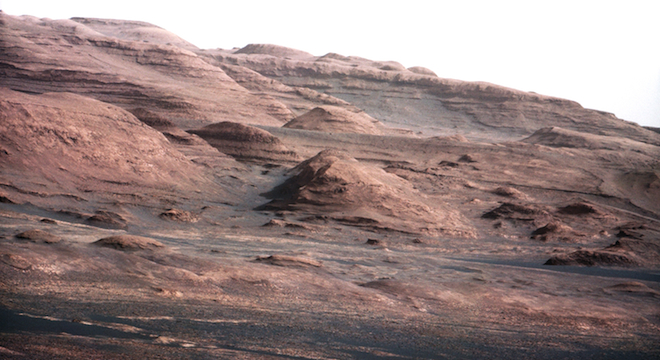NASA’s Mars Curiosity Rover has one specific feature on the Red Planet in its sights: Mount Sharp, a 3.4-mile high Martian mountain located near the rover’s landing site. Both are found inside Gale Crater, itself a 96-mile-wide shallow depression over which liquid water may have once flowed in the ancient history of Mars.
On Monday, NASA released a new batch of images snapped by the unmanned rover, including several new highly detailed shots of Mount Sharp, presently located about 15 miles south of the rover.
One image shows the mountain rising in the distance and the gravel-covered surface in front of the rover and leading up to the mountain’s edge.

Another, annotated image of the same scene by NASA online Monday provides some perspective of the vista, highlighting a rock about the same size as the Curiosity rover, itself a 10-foot-long, 9-foot-wide and 7-foot-tall machine:

NASA also posted the following full-color panorama of the rover’s surroundings and Mount Sharp’s peak standing tall in the distance:

The new color images snapped were with the telephoto lens on the rover’s 100-millimeter Mast camera, or Mastcam, the higher-resolution one of a pair of this type of camera installed on the rover. (Curiosity has 17 different cameras in total.)
Telephoto lenses provide a longer focal length, bringing distant objects into sharper view and providing a better perspective on images in the foreground.
The new images reveal numerous distinct, different-colored layers forming the mountain — called “strata” — each thought to correspond to a different era in Martian history, each with its own geologic makeup.
Scientists compared the exposed layers to those found on Earth in the Grand Canyon.
The exposed layers on Mount Sharp could help scientists figure out whether Mars ever possessed the conditions necessary to support carbon-based life, which is exactly why scientists have chosen this particular peak to study up close when they drive the six-wheeled rover toward and up it over the course of the next year (at the relatively quick rate of about 360 feet per day).
Mount Sharp, also known as Aeolis Mons, was named after NASA scientist and Caltech geologist Robert P. Sharp, who died in 2004.
NASA also posted new imagery captured by the rover’s twin black-and-white hazard avoidance cameras, or Hazcam, showing the rover body itself and the area immediately surrounding it, following its first scientific drive on Monday, distinct from the initial short test drive of about 20 feet from its landing site, which was completed on August 22.

Specifically, NASA is interested in studying noticeable burn marks left on the Martian surface by the rover’s landing craft rocket thrusters.
“We’ll be conducting a broad range of measurements over these marks,” said John Grotzinger, project manager for NASA’s Mars Science Laboratory mission, the formal name of the Curiosity exploration effort, in a press conference on Monday.
NASA also beamed-back the first ever human voice from another planet to Earth, playing an audio file stored on the rover’s onboard computer during the press conference of a speech by NASA Administrator Charles F. Bolden congratulating his team on the successful August 6 landing and the beginning of the 23-month-long official science mission.
NASA also announced on Monday that it plans to use the rover to beam back the first ever interplanetary music single release, a track called “Reach For The Stars,” by Black Eyed Peas and solo pop music artist Will.i.am.
With all of the high-quality multimedia data coming back from the rover so far, it seems that NASA’s latest venture on the Red Planet is a hit.






